Euphorbia milii
Euphorbia milii, the crown of thorns, Christ plant, or Christ's thorn, is a species of flowering plant in the spurge family Euphorbiaceae, native to Madagascar. The species name commemorates Baron Milius, once Governor of Réunion, who introduced the species to France in 1821.[2]
| Euphorbia milii | |
|---|---|
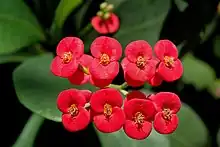 | |
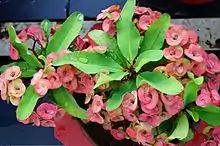 | |
| Scientific classification | |
| Kingdom: | Plantae |
| Clade: | Tracheophytes |
| Clade: | Angiosperms |
| Clade: | Eudicots |
| Clade: | Rosids |
| Order: | Malpighiales |
| Family: | Euphorbiaceae |
| Genus: | Euphorbia |
| Species: | E. milii |
| Binomial name | |
| Euphorbia milii | |
The native Malagasy name for this plant is songosongo also applied to several other Euphorbia species.[3] It is imagined that the species was introduced to the Middle East in ancient times, and legend associates it with the crown of thorns worn by Jesus.[4] It is commonly used as an ornamental houseplant that can be grown in warmer climates. The common English name[5] is due to the thorns and deep red bracts referring to the crown thorn Jesus had to wear during his crucifixion and his blood.
Description
It is a woody succulent subshrub or shrub growing to 1.8 m (5 ft 11 in) tall, with densely spiny stems. The straight, slender spines, up to 3 cm (1.2 in) long, help it scramble over other plants. The fleshy, green leaves are found mainly on new growth,[2] and are up to 3.5 cm (1.4 in) long and 1.5 cm (0.59 in) broad. The flowers are small, subtended by a pair of conspicuous petal-like bracts, variably red, pink or white, up to 12 mm (0.47 in) broad.[6] Wat Phrik in Thailand claims to be the home of the world's tallest Christ thorn plant.[7] The plant thrives between spring and summer but produces flowers all year round.
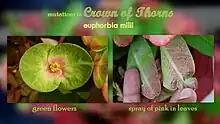
Toxicity
The sap is moderately poisonous, and causes irritation on contact with skin or eyes. If ingested, it causes severe stomach pain, irritation of the throat and mouth, and vomiting. The poisonous ingredients have been identified as phorbol esters.[8] It is very toxic to domesticated animals such as, horses, sheep, cats and dogs.[9] For humans it is mildly toxic and only acts as an irritant.
Uses
Pesticide
The plant itself has proven to be an effective molluscicide and a natural alternative to pest control. The World Health Organization (WHO) has recommended the usage of Euphorbia milii in aiding snail control.[10] Especially in endemic countries. Schistosomiasis is an infectious disease from freshwater parasites, carried by snails. Extracts from the plant are used to control the snail population to avoid getting infected from a parasite.[11]
Varieties
E. milii is a variable species, and several varieties have been described; some of these are treated as distinct species by some authors.[6] E. milii var. splendens (syn. E. splendens) is considered to be the living embodiment of the supreme deity in Bathouism, a minority religion practiced by the Bodo people of Eastern India and Nepal.
- Euphorbia milii var. bevilaniensis (Croizat) Ursch & Leandri 1955
- Euphorbia milii var. hislopii (N.E.Br.) Ursch & Leandri 1955 (syn. E. hislopii)
- Euphorbia milii var. imperatae (Leandri) Ursch & Leandri 1955
- Euphorbia milii var. longifolia Rauh 1967
- Euphorbia milii var. milii
- Euphorbia milii var. roseana Marn.-Lap. 1962
- Euphorbia milii var. splendens (Bojer ex Hook.) Ursch & Leandri 1955
- Euphorbia milii var. tananarivae (Leandri) Ursch & Leandri 1955
- Euphorbia milii var. tenuispina Rauh & Razaf. 1991
- Euphorbia milii var. tulearensis Ursch & Leandri 1955
- Euphorbia milii var. vulcanii (Leandri) Ursch & Leandri 1955
Cultivation
Euphorbia milii can be propagated from cuttings.[12] E. milii is not hardy, and does not tolerate temperatures below 10 °C (50 °F). In temperate areas it needs to be grown under glass in full sun. During the summer it may be placed outside in a sheltered spot, when all risk of frost is absent. The species[13] and the variety E. milii var. splendens[14] have both gained the Royal Horticultural Society’s Award of Garden Merit.[15]
Gallery
 Euphorbia milii, crown of thorns
Euphorbia milii, crown of thorns Christ thorn inflorescences (cyathia) opening
Christ thorn inflorescences (cyathia) opening Emerging stem
Emerging stem Christ thorn inflorescence (cyathium) close up view
Christ thorn inflorescence (cyathium) close up view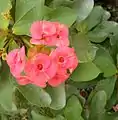 Euphorbia milii var splendens
Euphorbia milii var splendens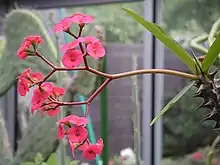 Euphorbia milii
Euphorbia milii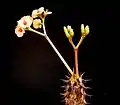 Euphorbia milii var. vulcanii
Euphorbia milii var. vulcanii Euphorbia milii var. milii
Euphorbia milii var. milii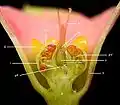 Longitudinal section of the cyathium
Longitudinal section of the cyathium Grown in Malaysia
Grown in Malaysia Flower buds of crown-of-thorns (Euphorbia milii).
Flower buds of crown-of-thorns (Euphorbia milii). Infected euphorbia inflorescences (cyathia)
Infected euphorbia inflorescences (cyathia) Close-up view of Euphorbia milii
Close-up view of Euphorbia milii In Prague botanic garden
In Prague botanic garden Euphorbia milii from Kerala, India
Euphorbia milii from Kerala, India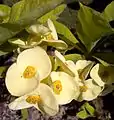 Euphorbia milii in Pakistan
Euphorbia milii in Pakistan Euphorbia milii in Bangladesh.
Euphorbia milii in Bangladesh. Thorns of Euphorbia milii.
Thorns of Euphorbia milii. Leaf of Euphorbia milii from the back.
Leaf of Euphorbia milii from the back. Leaf of Euphorbia milii from the back.
Leaf of Euphorbia milii from the back. Euphoria milii from Haryana, India
Euphoria milii from Haryana, India
References
- Razanajatovo, H. (2020). "Euphorbia milii". IUCN Red List of Threatened Species. 2020: e.T44389A153299391. doi:10.2305/IUCN.UK.2020-1.RLTS.T44389A153299391.en. Retrieved 19 November 2021.
- Ombrello, Dr T., Crown of Thorns, Plant of the Week, UCC Biology Department, archived from the original on 17 September 2009, retrieved 1 October 2009
- See:
- de La Beaujardière, Jean-Marie, ed. (2001). "Botanical scientific names: Euphorbia". Malagasy Encyclopedic Dictionary.
- Fouché, J. G.; Andriamanalintsoa, J.-J.; B., David (July 2013). "Le jardin botanique de Ranopiso : lieu de conservation et de connaissance ethnopharmacologique en Androy (Madagascar)". Ethnopharmacologia (in French). Société Française d'Ethnopharmacologie (50): 62–3.
- Chudasama, C.A.M. (2018). "Molecular marker study in ornamental plant Euphorbia milii". Journal of Pharmacognosy and Phytochemistry. 7 (3). Retrieved 10 December 2020.
- "Crown of Thorns". Retrieved 11 December 2020.
- Huxley, A., ed. (1992). New RHS Dictionary of Gardening. ISBN 978-0-333-47494-5.
- "ThaiTambon.com". Archived from the original on 2016-04-17. Retrieved 2007-10-26.
- "Crown-of-Thorns (Euphorbia milii)". Veterinary Medicine Library. University Library, University of Illinois at Urbana-Champaign. Archived from the original on 2017-03-23. Retrieved 2017-04-08.
- "Plants Toxic to Animals". Retrieved 18 December 2020.
- Souza, C.A.M. (November 1997). "Study of the embryofeto-toxicity of Crown-of-Thorns (Euphorbia milii) latex, a natural molluscicide". Brazilian Journal of Medical and Biological Research. 30 (11): 1325–32. doi:10.1590/S0100-879X1997001100011. PMID 9532242.
- de Carvalho Augusto, Ronaldo; et al. (July 28, 2017). "Double impact: natural molluscicide for schistosomiasis vector control also impedes development of Schistosoma mansoni cercariae into adult parasites". PLOS Neglected Tropical Diseases.
- Complete Guide to Houseplants. Meredith Publishing Group.
- "RHS Plantfinder - Euphorbia milii". Retrieved 23 February 2018.
- "RHS Plantfinder - Euphorbia milii var. splendens". Retrieved 14 February 2018.
- "AGM Plants - Ornamental" (PDF). Royal Horticultural Society. July 2017. p. 35. Retrieved 16 February 2018.
